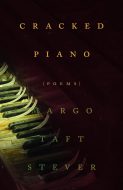 Margo Taft Stever
Margo Taft Stever
Cracked Piano
CavanKerry Press
Reviewer: Vivian Wagner
Margo Taft Stever’s Cracked Piano examines mental illness and trauma, particularly in the context of cultural cruelty and disconnection. At its heart is the story of Stever’s great-grandfather and the half-brother of president William Howard Taft, Peter Taft, who was kept for part of his life in the Cincinnati Sanitarium. In that cold and uncaring place, he was treated for mental illness with a version of the rest cure popular in the late nineteenth century.
The book includes a number of poems from Taft’s perspective, in the form of found poems based on letters he wrote from the asylum, as well as letters from his doctor, W.S. Chipley, to Taft’s family. Much of the rest of the collection examines the familial repercussions of this traumatic asylum stay, looking at the ways in which trauma can inform and shape a family for generations.
The rich, multilayered structure of the book gives voice both to those who experience trauma and those who cause it. At the same time, the poems look for hope and love—those elements of human existence that allow us to survive and endure.
The collection’s first poem, “Idiot’s Guide to Counting,” poses questions that set the tone for the entire book, beginning with this one:
How do you become one
with the horse, riding and becoming
the act of riding…
This seemingly simple question is, in fact, replete with complex nuance. It’s not just about horses, in other words, but also about how we tell a story of historical trauma even as we’re living it. Where does the past end and the present begin? It’s a theoretical question that finds its embodiment in specific memories:
How to become one with
the branches of a tree, a grandfather
tree in an apple orchard
that no longer exists?
These lines echo Taft’s story, as he’s both the poet’s great-grandfather and a man in his own right. This question about becoming one with the branches of a tree is, in part, a question about family trees, about reclaiming and writing the story of a world that no longer exists, even as it gave birth to the one that does.
In the next poem, “For Sale,” the speaker digs through similar layers of past and present, but this time through descriptions of a childhood home that is for sale: “My childhood house is stripped, / bared, open to the public.” Here, too, we hear of a family orchard with its branches:
Death can empty a house of shoes
worn and new, of children
who climbed the grandfather
trees, impressing outlines like fossils
littering the banks of the creek.
There’s an overriding sense of loss in the poem—loss of childhood, of history, and of a stable place from which to understand the world.
The book’s second section deals explicitly with the story of Taft. His supposed mental illness and the restrictive and inhumane treatment he receives are both on display. The poems question whether he was mentally ill at all, as his poems, based on actual letters, reveal that he was clear-thinking and intelligent, even as he was profoundly disturbed by the conditions in the asylum where he found himself.
The poem that gives the collection its title, for instance, opens as follows:
Dear Father,
I am alone this evening as every,
alone. An artist of imperfect
mind is endeavoring to extract
harmonious discords out of a cracked
piano just at my left.
It’s a haunting image of an artist trying to create art with the meager tools available—an “imperfect mind” and a “cracked piano.” In this way, the poem captures something about the state that all artists and poets find themselves in. All minds—and all instruments—are imperfect. Still, we must create.
The poem also contains a great deal of humor; for instance, Taft describes one of his fellow inmates, named Mr. Williams, as consisting “principally of hair.” There’s a sense in the poem, and throughout the collection, that humor is what will save us, even in the most difficult of situations.
The poems from the point of view of Taft’s doctor, Chipley, reveal the trappings of a cruel and inhumane medical establishment that emphasizes withdrawal and isolation over connection, as in these lines from “Causes of Mortification”:
It is
desirable for one in his condition
to abstract the mind as much as
possible from self and engagement
from other matters.
The Chipley poems stand in stark contrast to the Taft poems, revealing in the disjunction an unavoidable trauma—both for Taft and the family that would follow.
The last three sections of the collection focus on this inherited trauma, which is tempered only by layers of humor and love. In “Queen City,” the speaker revisits Cincinnati, a city that represents a kind of original sin, as it’s where Taft’s asylum had been. The city, for the speaker, embodies chaos, disappointment, and loss:
The city will always catapult me
to a childhood endlessly spinning
out of control.
Cincinnati, a place of “Mapplethorpe, race / riots, boycotts,” is an unsettled, haunted place, ultimately representing everything that the speaker would like—but can’t seem to—leave behind.
The collection’s last poem, “Bottomland,” represents both the burden of inherited and cultural trauma as well as the threads of resilience that allow for survival. The collection has several poems about mothers—mothers who fail to nourish and care for their offspring but who, nonetheless, love their children in the deeply flawed ways in which they can. “Bottomland” ends with an image of cold but indelible love:
From this stone, ageless heart,
remember your mother,
a mother who loved her children.
It’s a small consolation, perhaps, but it’s the only one we have. We’re all imperfect. We’re all cracked. Our culture’s tools and narratives are deeply flawed, emphasizing disconnection and isolation over care. But we will move forward, nourished by whatever incomplete tenderness we can find.

